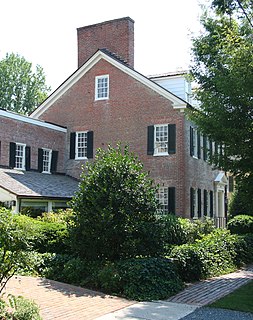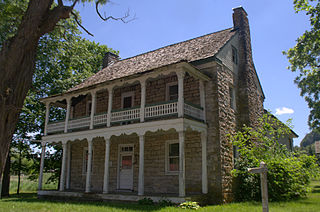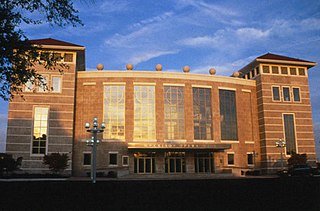
Buildings, sites, districts, and objects in Virginia listed on the National Register of Historic Places:

Green Springs National Historic Landmark District is a national historic district in Louisa County, Virginia noted for its concentration of fine rural manor houses and related buildings in an intact agricultural landscape. The district comprises 14,000 acres (5,700 ha) of fertile land, contrasting with the more typical poor soil and scrub pinelands surrounding it.

The Adam Thoroughgood House is a brick house located at 1636 Parish Road, in the neighborhood of Thoroughgood, in Virginia Beach, Virginia, United States. It was built ca. 1719. The building underwent major restorations in 1923 and in the 1950s and has served as a museum since opening to the public April 29, 1957. Much of the current structure was most likely the house of the great-grandson of Adam Thoroughgood. The City of Virginia Beach acquired the property in 2003. A 2004 grant application to the National Park Service resulted in a $150,000 award from the prestigious Save America's Treasures program. The City matched that amount as required. This restoration took longer and cost more than expected, but the house reopened in May 2011.

The Cannonball House in Saint Michaels, Maryland, United States, is a historic house built in the early 19th century. The Federal style house is a side-hall double-parlor design on a corner lot, built for shipbuilder William Merchant. It is historically notable for an 1813 event in the War of 1812 in which the British fleet bombarded Saint Michaels, leaving a cannonball embedded in the house.

The Norfolk Grange Hall, previously known as First Baptist Church, is a historic Grange hall and former Baptist church at 28 Rockwood Road in Norfolk, Massachusetts. Built in 1863, it is one of the town's few surviving 19th-century civic buildings. Since 1921 it has been owned by the Norfolk Grange # 135 and used as its meeting hall. It was listed on the National Register of Historic Places in 1989.

Elk Hill is a historic house and farm complex located near Nellysford, Nelson County, Virginia. It is one of the earliest extant farms in Nelson County. The 173-acre (0.70 km2) rural farm bounded in part by the South Fork of the Rockfish River and Reid's Creek. The main house is a substantial two-story, three-bay wide frame dwelling with a central hall plan, with the original portion built between 1790 and 1810. The house underwent a series of 19th-century additions and a major remodeling in 1902 in the neoclassical style. The contributing outbuildings include: smokehouse, built in the last quarter of the 18th century; tobacco barn, built circa 1790-1810; 19th century chicken house, two seat outhouse, and double crib barn; garages built in 1902 and in 1955; and a stone boundary/retaining wall, built in the last quarter of the 18th century.

Barnaby House is a historic home in Oxford, Talbot County, Maryland, United States. It is a 1 1⁄2-story, side-hall / double-pile frame house erected in 1770. It features a steeply pitched wood shingle roof marked by two shed-roofed dormers and a single-story brick-ended kitchen wing. It is one of only three 18th-century buildings remaining in Oxford.

Llandaff House is a historic home in Easton, Talbot County, Maryland, United States. It is a 2 1⁄2-story irregular plan frame house built in 1877-78, in a combined Queen Anne and Eastlake style. It features an asymmetrical front facade with a central entrance incorporated in a projecting two-story, two-bay pavilion distinguished by an open porch on the first floor. Also on the property are a late-19th-century three-story combination water tower and windmill and an early-20th-century frame boathouse. The grounds were professionally designed and executed by New York landscape architect Thomas Hogan.
In the United States, the National Register of Historic Places classifies its listings by various types of architecture. Listed properties often are given one or more of 40 standard architectural style classifications that appear in the National Register Information System (NRIS) database. Other properties are given a custom architectural description with "vernacular" or other qualifiers, and others have no style classification. Many National Register-listed properties do not fit into the several categories listed here, or they fit into more specialized subcategories.

Farmington is a house near Charlottesville, in Albemarle County, Virginia, that was greatly expanded by a design by Thomas Jefferson that Jefferson executed while he was President of the United States. The original house was built in the mid-18th century for Francis Jerdone on a 1,753-acre (709 ha) property. Jerdone sold the land and house to George Divers, a friend of Jefferson, in 1785. In 1802, Divers asked Jefferson to design an expansion of the house. The house, since greatly enlarged, is now a clubhouse.

Old Stone Tavern, also known as Rock House, is a historic inn and tavern located near Atkins, Smyth County, Virginia. It was built about 1815, and is a two-story, three bay, limestone structure with a central-hall plan. A frame rear ell was added in the mid-19th century. It has a side gable roof. The front facade features a mid-19th century porch supported by chamfered columns connected on each level by a decorative cyma frieze and sawn balustrade. The tavern was built to accommodate travelers in the heavy migration through Cumberland Gap to the west in the early 19th century.

Taylor–Whittle House is a historic home located at Norfolk, Virginia. It was built about 1791, and is a two-story, three-bay, 40 feet square, Federal style brick townhouse. The house has a pedimented gable roof, and a small pedimented roof supported on Doric order columns over the porch. It has a brick and frame rear kitchen ell. There is a two-level Italianate style porch added to the garden side. The Norfolk Historic Foundation took possession of the house in 1972, and house has served as the offices of the Norfolk Historical Society and the Junior League of Norfolk-Virginia Beach until 2011.

Norfolk City Hall, also known as the MacArthur Memorial, is a historic city hall located at Norfolk, Virginia. It was built in 1847, and is a two-story, stuccoed and granite faced, temple-form building measuring 80 feet by 60 feet. It features a front portico supported by six massive Tuscan order columns, and a gable roof topped by a cupola. The building housed city offices until 1918, and courtrooms until 1960.

Old Norfolk City Hall, also known as the Seaboard Building and U.S. Post Office and Courthouse, is a historic city hall located at Norfolk, Virginia. It was built in 1898-1900, and is a three-story faced with rusticated stone and yellow brick in a Neo-Palladian Revival style. It features a central pedimented engaged portico with Corinthian order pilasters that contains the main entrance. The building housed a post office and Federal courts until they moved to the Walter E. Hoffman United States Courthouse about 1935. Title to the building was transferred from the U.S. government to the city of Norfolk in 1937, when it was converted into a city hall.

Poplar Hall is a historic plantation house located at Norfolk, Virginia. It was built about 1760, and is a two-story, five-bay, Georgian style brick dwelling. It is covered with a slate gable roof and has interior end chimneys. It features a central one-bay dwarf portico and a low, hipped roof topped by a three-bay cupola. Both entrances are sheltered by a dwarf portico. A one-story brick wing was added about 1860, a frame addition in 1955, and a one-story frame wing in 1985. Also on the property is a contributing dairy. The house was built for Thurmer Hoggard, a planter and ship's carpenter who developed a private shipyard on the site.

The West Freemason Street Area Historic District is a national historic district located at Norfolk, Virginia. It encompasses 48 contributing buildings in a primarily residential section on the western edge of the center city of Norfolk. It developed between the late-18th and early-20th centuries and includes notable examples of the Federal, Greek Revival, and Late Victorian styles. Notable buildings include the Glisson House, Whittle House, McCullough Row, and the Camp-Hubard house. Located in the district is the separately listed Allmand-Archer House.

Newtown Historic District is a national historic district located at Staunton, Virginia. The district encompasses 414 contributing buildings and 2 contributing sites in a primarily residential section of Staunton. The district includes some late 18th- and early 19th-century structures, but most of the homes were built between 1870 and 1920 during Staunton's boom years. The buildings range from Jeffersonian Neo-Classical and Greek Revival to bungalows of the 1920s. Notable buildings include Stuart Hall's Cochran House (1858), Robertson House (1886), the Smith Thompson House, and the George M. Cochran House. The magnificent grounds of Thornrose Cemetery are also included in the district. Located in the district are the separately listed Stuart Hall School, Stuart House, and Trinity Episcopal Church.

The Norfolk Auto Row Historic District encompasses a commercial district just outside the downtown area of Norfolk, Virginia. The area is bounded on the south by West Brambleton Avenue, on the east by Monticello Avenue, on the north by East 13th Street, and on the west by Llewelllyn Avenue and Granby and Boush streets. The area was originally developed as a low-income housing area early in the 20th century, but was by the mid-20th century completely transformed into an area of commercial development, mainly for the sales and service of automobiles. The district features buildings that are mostly one and two stories, although there is one 14-story skyscraper. One notable structure in the district is the Harrison Opera House, built in 1944 as an Army and Navy USO facility; it served as the city's major performance venue until it was eclipsed in 1970 by the construction of the Norfolk Scope arena.

Freeman House, also known as The Stateline House, is a historic home located on the North Carolina-Virginia state line near Gates, Gates County, North Carolina, USA. The house was built in three building phases, the earliest perhaps dating to the late-18th century. The farmhouse was initially built following the basic early-Federal-style one-room plan, followed by the addition of a late-Federal-style two-story side-hall-plan, which was finally enlarged and converted in the mid-19th century to a more substantial Greek Revival style, center-hall-plan dwelling. The main section is a two-story, five bay, frame structure. Also on the property are the contributing smokehouse, a kitchen with exterior end chimney, a one-story tack house with an attached wood shed, a small, unidentified shed, two large barns, and a stable.
























